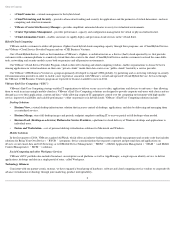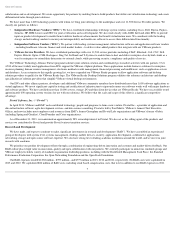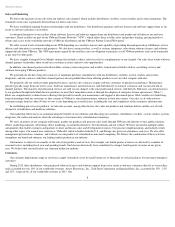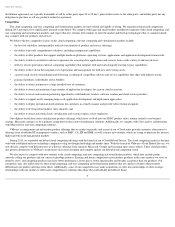VMware 2013 Annual Report Download - page 18
Download and view the complete annual report
Please find page 18 of the 2013 VMware annual report below. You can navigate through the pages in the report by either clicking on the pages listed below, or by using the keyword search tool below to find specific information within the annual report.
Table of Contents
solutions, and Microsoft and Hewlett-Packard continued their collaboration based on Microsoft’s cloud computing and virtualization platforms. In addition,
Citrix offers an IaaS cloud services solution, and Red Hat continued to invest in the Open Virtualization Alliance (“OVA”) to bolster KVM as a direct
competitor to VMware vSphere. In 2012, Dell acquired Wyse Technologies to bolster its ability to serve the “cloud client” market and Quest to enhance its
management and automation solutions. A number of competitors are active in the emerging software-defined networking space. For example, in 2013, Cisco
acquired Insieme, and Juniper acquired Contrail Systems in late 2012. In June 2013, Oracle and Microsoft entered into a partnership pursuant to which Oracle
now supports the use of Oracle products in Microsoft Hyper-V deployments as well as Windows Azure. We expect these trends to continue as companies
attempt to strengthen or maintain their market positions in the evolving virtualization infrastructure and enterprise IT solutions industry. Many of the
companies driving this trend have significantly greater financial, technical and other resources than we do and may be better positioned to acquire and offer
complementary products and technologies. The companies and alliances resulting from these possible combinations may create more compelling product and
service offerings and be able to offer greater pricing flexibility than we can or may engage in business practices that make it more difficult for us to compete
effectively, including on the basis of price, sales and marketing programs (such as providing greater incentives to our channel partners to sell a competitor’s
product), technology or product functionality. This competition could result in a substantial loss of customers or a reduction in our revenues, which could
materially and adversely impact our financial condition and results of operations.
We may not be able to respond to rapid technological changes with new solutions and services offerings, which could have a material adverse effect on
our sales and profitability.
The virtualization, cloud computing, end-user computing, and SDDC industries are characterized by rapid technological changes, changing customer
needs, frequent new software product introductions and evolving industry standards. The introduction of third-party solutions embodying new technologies
and the emergence of new industry standards could make our existing and future software solutions obsolete and unmarketable. Cloud computing is proving
to be a disruptive technology that will alter the way that businesses consume, manage and provide physical IT resources, applications, data and IT services.
We may not be able to establish or sustain our thought leadership in the cloud computing and enterprise software fields, and our customers may not view our
products and services as innovative and best-of-
breed, which could result in a reduction in market share and our inability to command a pricing premium over
competitor products and services. We may not be able to develop updated products and services that keep pace with technological developments and
emerging industry standards and that address the increasingly sophisticated needs of our customers or that interoperate with new or updated operating
systems and hardware devices or certify our products and services to work with these systems and devices. As a result, we may not be able to accurately
predict the lifecycle of our software solutions, and they may become obsolete before we receive the amount of revenues that we anticipate from them. There
is no assurance that any of our new offerings would be accepted in the marketplace. Significant reductions in server-related costs or the rise of more efficient
infrastructure management software could also affect demand for our software solutions. As hardware and processors become more powerful, we will have to
adapt our product and service offerings to take advantage of the increased capabilities. For example, while the introduction of more powerful servers presents
an opportunity for us to provide better products for our customers, the migration of servers to microprocessors with an increasing number of multiple cores
also allows an end user with a given number of licensed copies of our software to multiply the number of virtualization machines run per server socket
without having to purchase additional licenses from us. If we are unable to revise our solutions and offerings in response to new technological developments,
our ability to retain or increase market share and revenues in the virtualization software market could be materially adversely affected.
Our operating results may fluctuate significantly, which makes our future results difficult to predict and may result in our operating results falling below
expectations or our guidance and cause the price of our Class A common stock to decline.
Our operating results may fluctuate due to a variety of factors, many of which are outside of our control. As a result, comparing our operating results on a
period-to-period basis may not be meaningful. Our past results should not be relied upon as an indication of our future performance. In addition, a significant
portion of our quarterly sales typically occurs during the last month of the quarter, which generally reflects customer buying patterns for enterprise
technology. As a result, our quarterly operating results are difficult to predict even in the near term. If our revenues or operating results fall below the
expectations of investors or securities analysts or below any guidance we may provide to the market, the price of our Class A common stock would likely
decline substantially.
In addition, factors that may affect our operating results include, among others:
16
• general economic conditions in our domestic and international markets and the effect that these conditions have on our customers’ capital budgets
and the availability of funding for software purchases;
•
fluctuations in demand, adoption rates, sales cycles and pricing levels for our products and services;
•
fluctuations in foreign currency exchange rates;
























